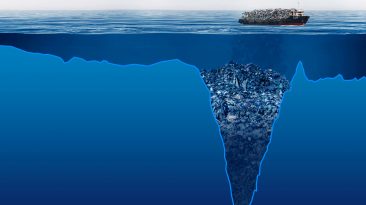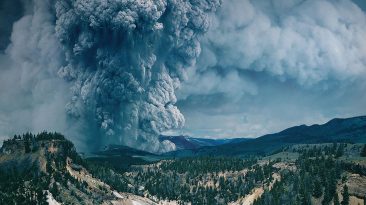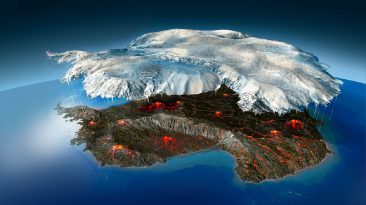Has the weather ever ruined your plans? What if I told you I had an idea to stop hurricanes from wrecking your day? And that it involves liquid nitrogen.
How exactly would liquid nitrogen stop a hurricane? How much of this icy cold substance would we need? And how would we pull this off?
Wait, why would we need liquid nitrogen? Couldn’t we get by with a lot of ice?
In 1947, Nobel Prize-winning chemist Irving Langmuir led a U.S. military experiment to pour ice into Hurricane King to make it lose its strength. And, umm, it didn’t quite go as planned. And that isn’t even the craziest thing we humans have come up with. Some of us would be happy to blow up a hurricane with a nuke. Or push a swirling storm away by pointing a lot of fans at it. But that’s a story for some other time.
Now, let’s get back to liquid nitrogen. Nitrogen has a boiling point of -196 ºC (-320.8 ºF). And it has the power to freeze things instantly. And if we poured some liquid nitrogen in a baking hurricane, it should make it go away. But how exactly would we do it?
Why does cooling a hurricane sound like a great idea? Well, hurricanes happen when warm ocean water causes the rise of moist air from its surface. This creates a cycle of clouds that form and spin rapidly. As particles get heated, they move faster and spread out further away from each other. That makes the winds blow faster until they eventually grow into a violent storm. Warm water is what drives the hurricanes. And the easiest way to stop this disastrous storm is to cool the ocean water.
The idea is simple. If you released liquid nitrogen into the ocean, it would instantly evaporate. And warm water would act as a fuel for this evaporation. As the water particles were losing their energy to the nitrogen, water molecules would begin to slow down. They would come closer and closer together until they formed ice. The cooler temperature would then slow down the winds. And that would end the storm. Theoretically. If only it were that simple.
We know that hurricanes thrive off warm water and warm moist air. And we know that cooling down the water and air around the hurricane should stop this disaster. The problem is, hurricanes are large. The central part of a hurricane, called the eye, can be anywhere between 30 to 65 km (18 to 40 mi) in diameter.
Your best bet would be to freeze the hurricane all around and not just its eye. The hurricane is traveling at speeds of 120 km/h (74 mph). And that makes its average diameter roughly 16 km (100 mi), and its circumference about 500 km (314 mi).
So by our calculations, to surround a hurricane and freeze it, you would need over 32,000 metric tons (35,325 U.S. tons) of liquid nitrogen. It would be like having 16 Olympic-sized swimming pools filled with the stuff. That is a lot of liquid nitrogen to transport. How can we even deliver all of this to the epicenter of our scenario? I’d say we would need a lot of helicopters.
The biggest heavy-lifter of the helicopter world can carry about 20,000 kg (44,000 lb). So if you got your hands on this tech, you’d require over 1,600 of these copters to carry the load. That sounds like an expensive endeavor. Now, imagine you had all the necessary resources, and you were about to dump all that liquid nitrogen into the ocean. Now what?
If you were one of those brave volunteers transporting the liquid nitrogen, you should be ready for one thing. It would be painfully difficult to breathe. That’s because, upon its release into the water, the liquid nitrogen would evaporate. The air around you would have too much nitrogen and not enough oxygen. So better grab your oxygen tank.
But that’s just the beginning of the trouble. Freezing that much of the surface of the ocean could block sunlight from deeper waters. This would interfere with marine plant photosynthesis. Marine plants form the base of the food chain in the ocean. They provide nearly half of the oxygen we breathe. And don’t get me started on how unbearable life would be without oxygen. You’d probably have to carry tanks around and figure out a way to help the animals.
It looks like you’d be better off waiting for a hurricane to die off naturally. Usually, that takes about 12 to 24 hours. Freezing a hurricane with liquid nitrogen would be expensive, dangerous, and likely, impossible.
Sources
- “No, you can’t just nuke a hurricane. But there are other options.”. Umair Irfan. 2017. Vox.
- “Why You Can’t Nuke A Hurricane”. Eric, Grundhauser. 2017. Atlas Obscura.
- “The Chemist Who Thought He Could Harness Hurricanes”. Kean, Sam. 2017. The Atlantic.
- “Greek letters ‘will never be used again’ to name hurricanes”. Justine, Calma. 2021. The Verge.
- “Today is the last day of the record-smashing 2020 Atlantic hurricane season”. 2020. The Verge.



























